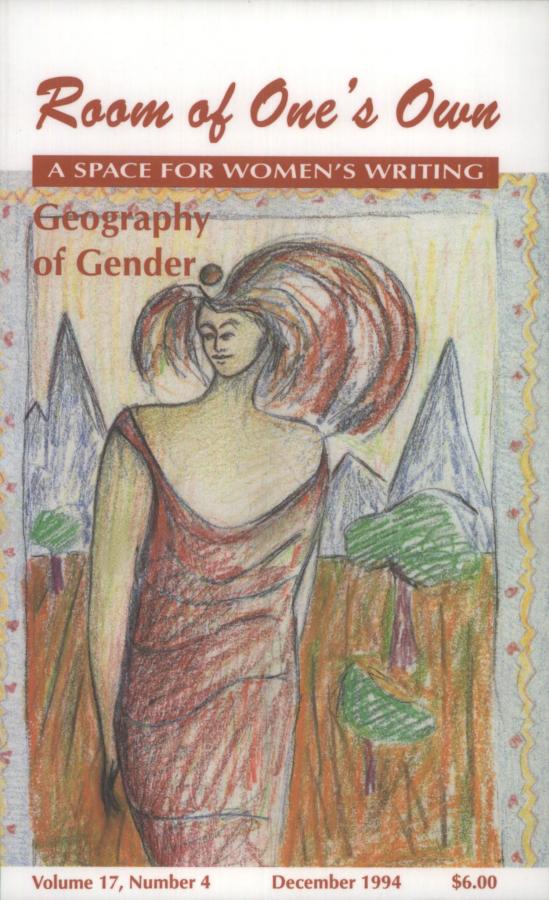Geography of Gender | 17.4
1994
Digital only; out of stock in print.
The women of the Growing Room Collective, who produce Room of One’s Own, are tremendously pleased to announce the winners of our first annual literary competition. About one hundred writers entered pieces in the contest. We narrowed our final selections down to a dozen, which were then given over to one of Canada’s hottest new authors to read. Many of you will be familiar with the name Gayla Reid. Not only is she the most recent winner of the prestigious Journey Prize and this year’s CBC/Saturday Night short fiction award, Gayla was one of the founding members of Room of One’s Own and a Growing Room Collective member for over a decade.
Congratulations to Byma Barclay on winning our “In the First Person” contest. Congratulations, too, to our other winners: Meredith Woodward and Maggie Dwyer, and to the other finalists whose work appears in this issue.
We chose to call our contest “In the First Person” not because we expected stories to be written from a first-person perspective, but because of our commitment to making room in the world for quality writing by women. “In the First Person” reinforces the idea that women can be first and foremost in some arenas, that writing about women’s experiences does not necessarily relegate us to the specialty shelves of “special interest” groups.
The theme chosen for our first contest, Geography of Gender, is equally appropriate for a journal of women’s writing.The notion that place and space has gender implications has been recognized only recently. My first introduction to this topic was at a panel discussion of Geomatria, a group of architects and artists in Montreal. Their analyses of the relationship of public space to women’s issues, such as safety and functionality, brought together fragments of ideas that worried at my feminist conscience but had never coalesced into a theory.
After that, the concept became abundantly clear, and I was able to question issues in a more constructive way. When restricted visitor parking in some areas of a city is intended to make parking spaces open for local residents, I could ask if anyone considered what this meant for women in terms of personal safety. Would increased lighting be part of the plan? Will safe corridors be identified for women visiting the neighbourhood? When building designers create isolated corridors or secluded nooks for dramatic effect, when university officials decide to relegate certain programs – with mostly women enrolled-to a secluded campus where they are unable to provide adequate security, when home designers don’t take into consideration the needs of the women whose responsibility it will be to run the place, it becomes easier to make the connections between gender and geography.
This is by no means the only interpretation of geography of gender. Mary May Lombardi’s collection on the poetry of Elizabeth Bishop, also entitled Elizabeth Bishop: The Geography of Gender, explores the role of gender in the world of literature. Ironically, Lombardi reports that Elizabeth Bishop chose not to be published in a “women’s” literary journal for fear that her work would not be judged on merit, but instead “ghettoized”to the realm of “women poets”—in her day, a class below that of real poets.
The geography of gender in the arts remains a relevant topic. While some women have transcended the barrier and begun to enjoy the competition and camaraderie of the world of poets, they are a privileged few. Instead, we are creating—in places like Room of one’s Own— a parallel place where women’s work is judged, not because we are women, but because the subjects we choose to pursue are valued in and of themselves.
—Wendy Putnam

$10.00
Additional information
| Delivery | Canada, USA, International, Digital |
|---|
In this issue: Karen Abrahamson, Byrna Barclay, D.M. Blais, J.M. Bridgeman, Ronnie R. Brown, Cathy Campbell, Su Croll, Maggie Dwyer, Wendy Putman, Barbara Schott, Margaret Anne Schmidt, Janice Williamson, Meredith B. Woodward, Arlene Zide